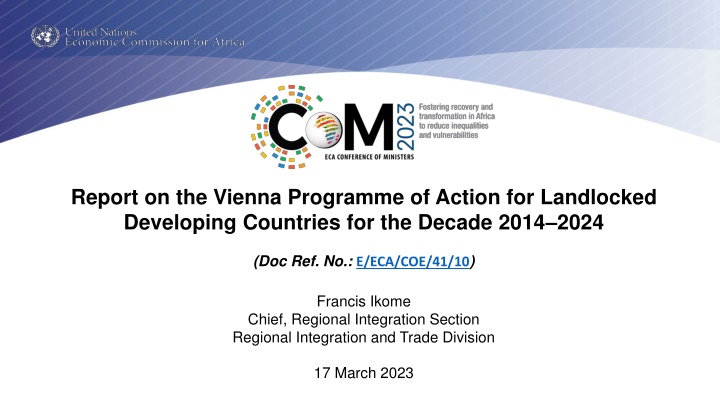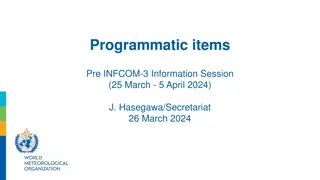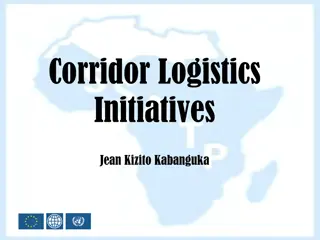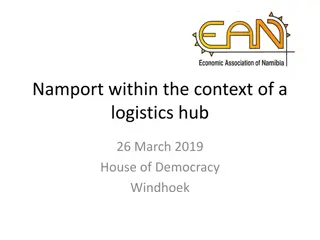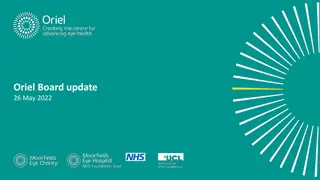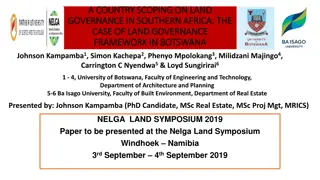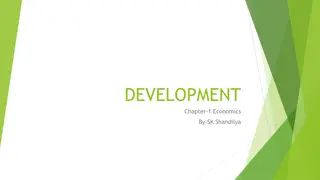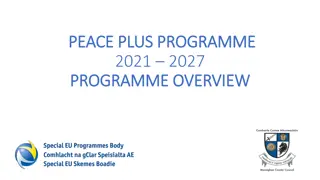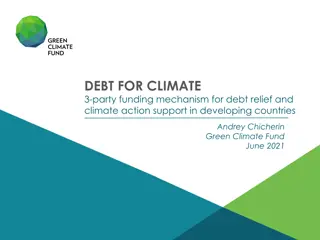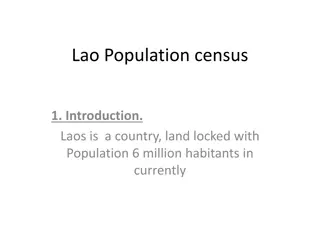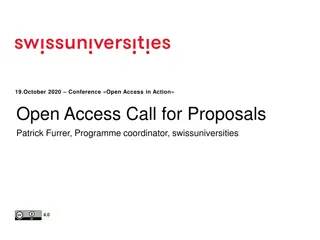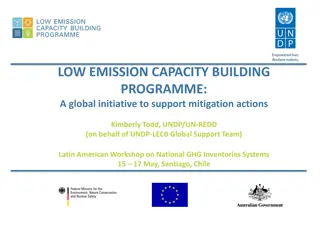Report on the Vienna Programme of Action for Landlocked Developing Countries (2014-2024)
Africa, home to 16 of the world's 32 landlocked developing countries, faces challenges from COVID-19 and the Ukraine war, impacting food security and inflation. The report highlights the economic growth projections, key themes for African LLDCs, expected inflation rates, progress in vaccination and HIV rates, and the infrastructure and ICT constraints. Recommendations include implementing the AfCFTA, advancing industrialization, and addressing the infrastructure deficit.
Download Presentation

Please find below an Image/Link to download the presentation.
The content on the website is provided AS IS for your information and personal use only. It may not be sold, licensed, or shared on other websites without obtaining consent from the author.If you encounter any issues during the download, it is possible that the publisher has removed the file from their server.
You are allowed to download the files provided on this website for personal or commercial use, subject to the condition that they are used lawfully. All files are the property of their respective owners.
The content on the website is provided AS IS for your information and personal use only. It may not be sold, licensed, or shared on other websites without obtaining consent from the author.
E N D
Presentation Transcript
Report on the Vienna Programme of Action for Landlocked Developing Countries for the Decade 2014 2024 (Doc Ref. No.: E/ECA/COE/41/10) Francis Ikome Chief, Regional Integration Section Regional Integration and Trade Division 17 March 2023
Introduction Africa is home to 16 of the world s 32 landlocked developing countries and 13 of these are also LDCs. The double crisis COVID-19 and the war in Ukraine has worsened food insecurity and inflation on the continent due to spikes in food, fertilizer and fuel prices. Africa LLDCs real GDP growth is expected to be higher than that of developing countries and the African continent in 2023 and 2024. Economic growth of LLDCs in Africa, 2019 2024 8 6.6 6 4.8 4.7 4.7 4.4 4.3 4.2 3.9 Real GDP Growth (%) 3.7 3.7 3.7 3.6 4 3.4 3.1 Key themes for African LLDCs Effectively implementing the AfCFTA Ratifying the Protocol on the Free Movement of Persons, Right of Residence and Right of Establishment Advancing structural economic transformation through industrialization 2.9 2 0 2019 2020 2021 2022 2023 2024 -2 -1.8 -1.9 -2.6 -4 Axis Title Africa LLDCs Emerging Market and developing economies
Socioeconomic Development of African LLDCs Expected inflation in 2023 (%) Some African LLDCs are among the countries with the highest inflation rates on the continent. High inflation worsens poverty and vulnerability. The 4 African countries that have been hit the hardest by inflation in food prices (Ethiopia, Malawi, Burkina Faso and Rwanda) are landlocked. Energy security has also been compromised since the continent is highly dependent on imported refined petroleum products. Progress in the rate of vaccination against COVID-19 in African LLDCs has been mixed, and HIV continues to affect countries. Zimbabwe 204.60% South Sudan 28.60% Ethiopia 21.70% Malawi 15.50% Source: IMF Percentage of the population that has received at least one dose of COVID-19 vaccine Lesotho 78.6 Rwanda 69.9 Botswana 56 Burkina Faso 13.9 Mali 12.5 Burundi 0.2 0 10 20 30 40 50 60 70 80 90 Source: WHO
Infrastructure Development and Maintenance The infrastructure deficit and the high cost of logistics constitute major constraints to the growth of these countries and to the full implementation of the VPoA. Paved road density in African LLDCs is 10.59 km per 1,000 km2, which is nearly half the landlocked developing countries (24.66 km per 1,000 km2). The Trans-African Highway seeks to address road transport deficit, but its operationalization hampered by missing links and poor maintenance in some key segments. Infrastructure inefficiencies hinder intra- African trade and competitiveness of LLDCs. average for all continues to be international
Information and Communications Technology COVID-19 has accelerated Internet uptake in Africa. In 2022, 39.7% of the African population was using the Internet, compared with 27.7% in 2019. However, this was still far below the world average of 66% in 2022. Progress has been mixed in African LLDCs. In 2020, 64% of the population in Botswana was using the Internet, compared with only 6.1% in Uganda. Mobile phone usage in Africa has increased significantly. On average, there were 87 mobile cellular subscriptions per 100 people in Africa in 2020. The average for landlocked developing countries was slightly lower, at 73 subscriptions per 100 people. High prices for ICT hamper the capacity of LLDCs to harness the full benefits of the digital economy and reap the maximum trade and development benefits that should accrue from the use of emerging technologies. % of Africans using the Internet 66% 66% World World 54% 54% 39.7% 39.7% 27.7% 27.7% 2019 2019 2022 2022 Source: ITU
Conclusion and Key Policy Recommendations Infrastructure development and maintenance Catalyze investments to address the gaps in transport infrastructure, renewable energy, ICT and digital transformation, industrialization and regional integration; Regional Cooperation Leveraging support from development partners, all LLDCs and transit countries should ratify and effectively implement the AfCFTA and the AU Protocol on the Free Movement of Persons, working with UNECA on country-specific strategies to maximize gains from the AfCFTA. Health Develop resilient health systems not only to respond to disease outbreaks but also to build a strong primary health-care foundation to address pre-existing inequities among vulnerable populations by improving access to equitable, safe and affordable medicines;
THANK YOU! Follow the conversation: #COM2023 More: www.uneca.org/cfm2023
